Abstract
Several metals such as arsenic, beryllium, chromium and nickel are carcinogenic to man when they occur in certain well-defined physicochemical forms. The carcinogenic potential of these metals is linked to their mutagenic properties. The determination of the metal or possibly of its metabolites in biological media and the cytogenetic examination of somatic cells are two methods that can currently be used to monitor exposure of populations at risk. Due to the use of inappropriate methodology, the value of the positive cytogenetic results published so far appears questionable. By contrast, the concentrations of metals in blood, urine, or other biological materials can be determined with accurate and precise methods. Although it does not permit a direct assessment of the carcinogenic risk, this approach is currently the most suitable for monitoring exposed populations.
Full text
PDF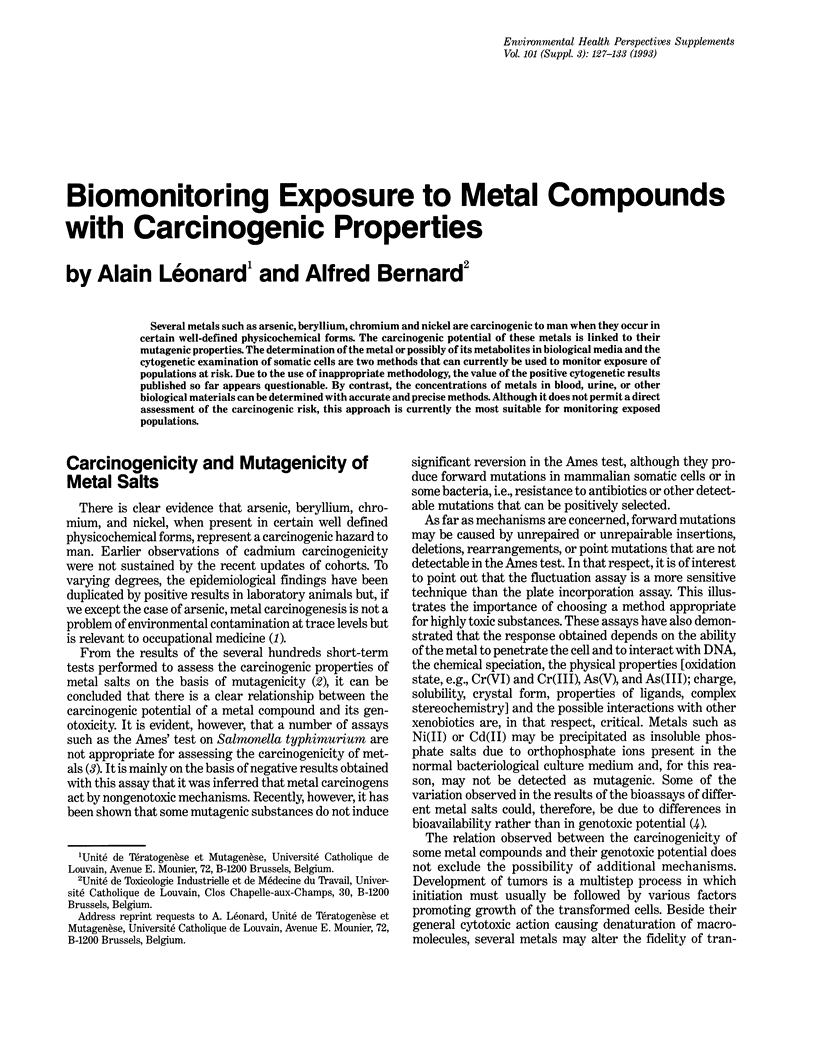
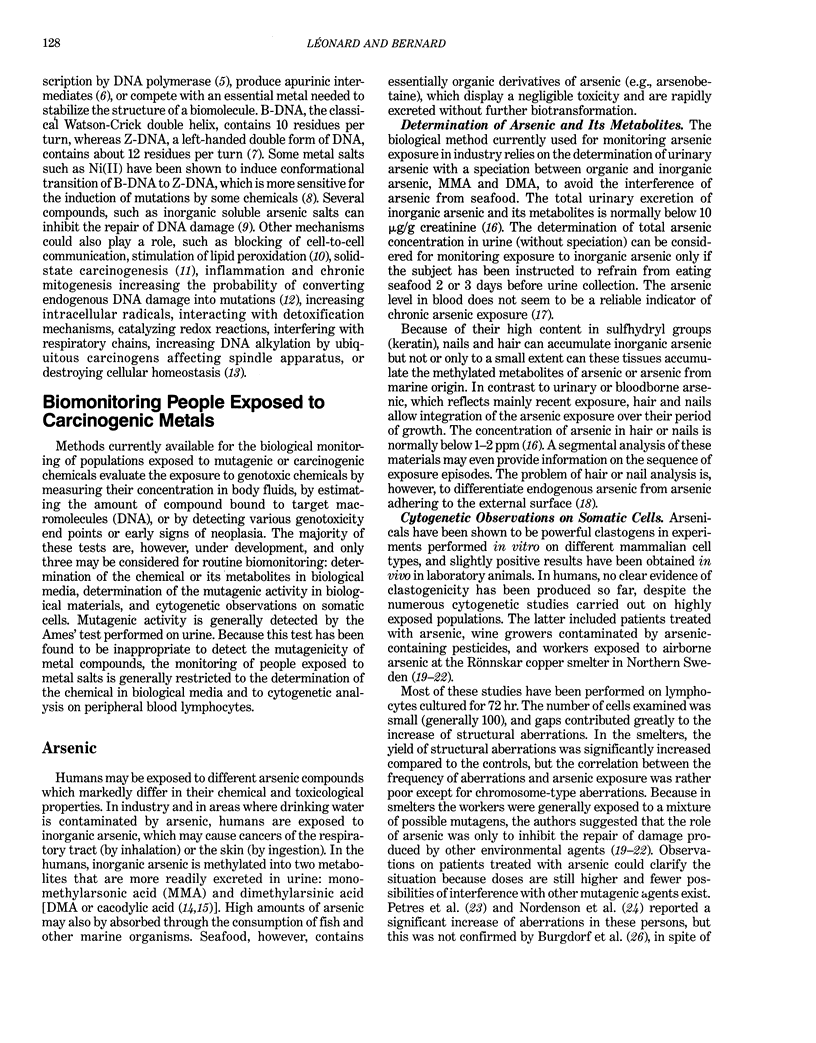
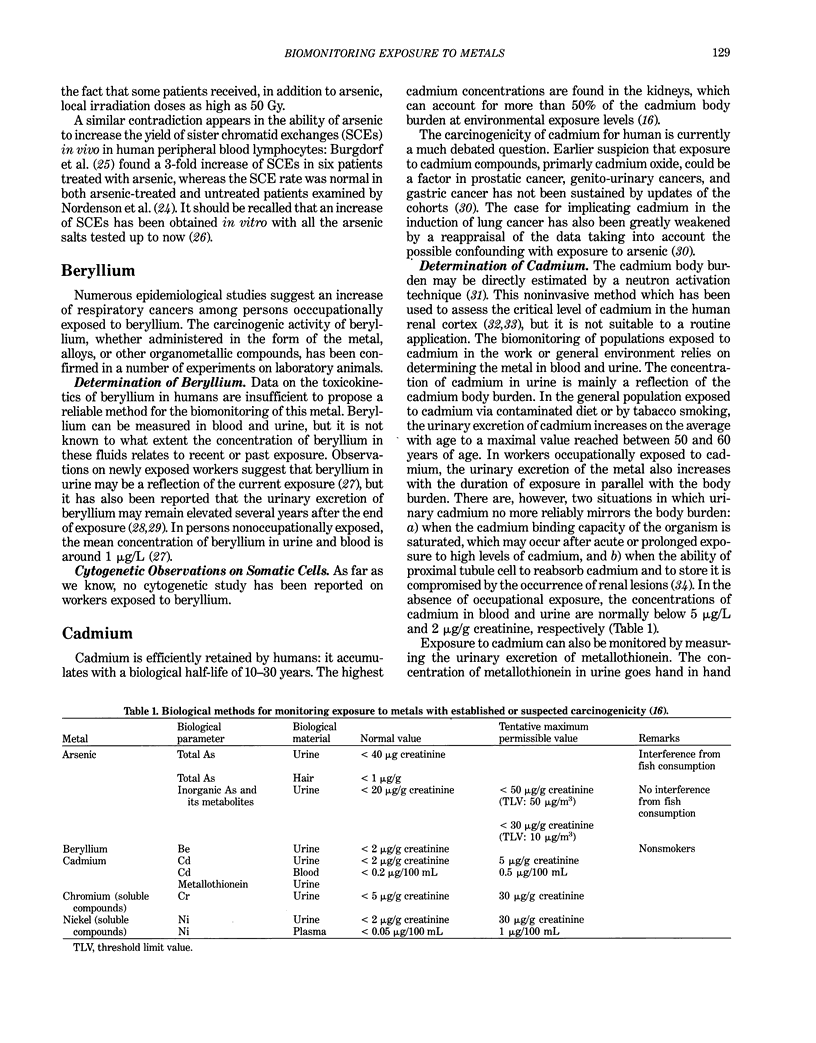
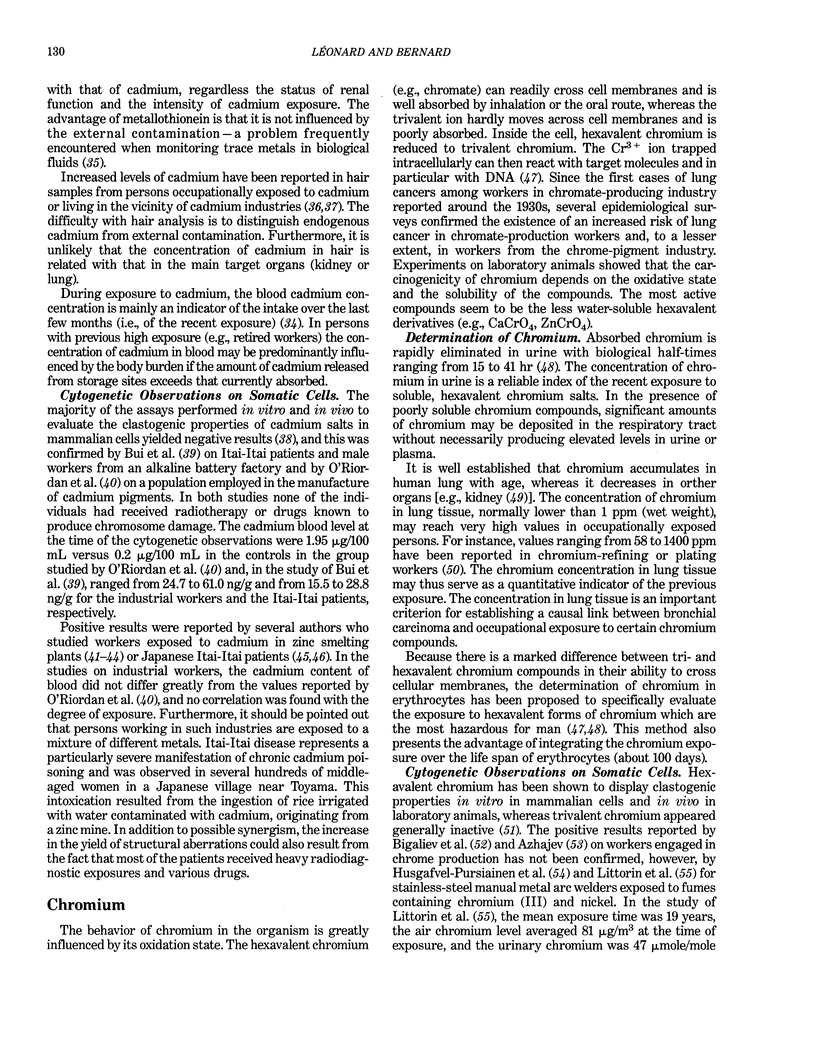
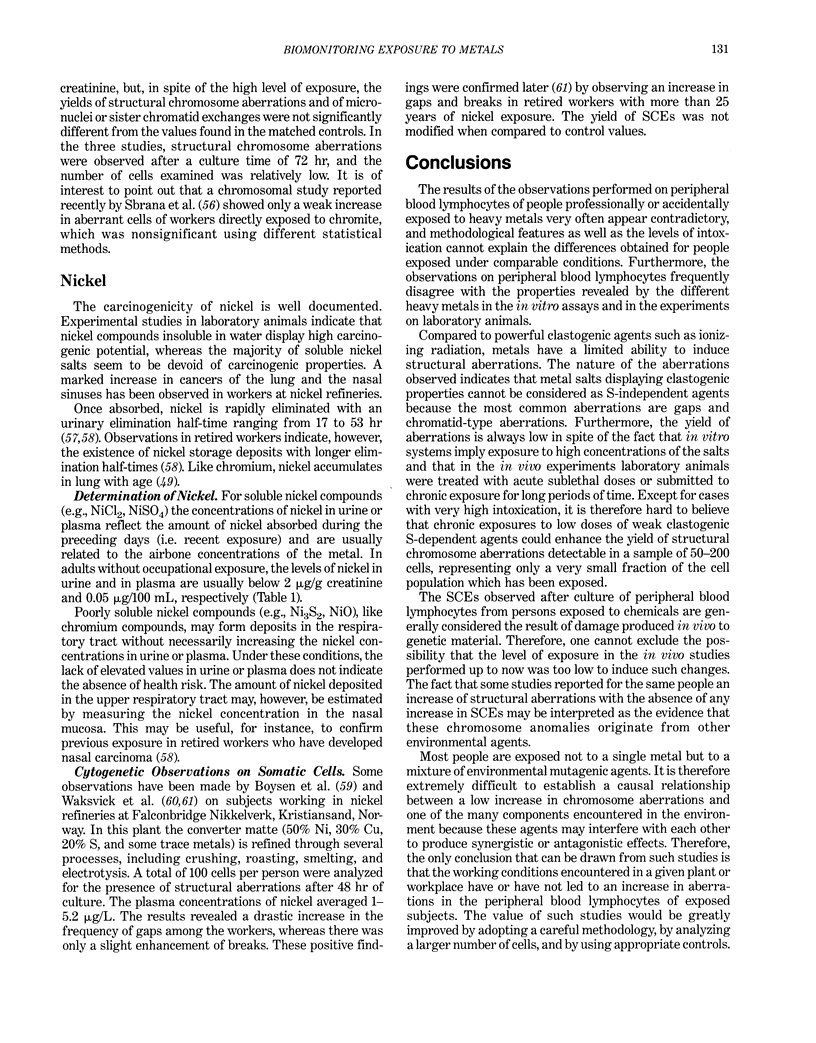
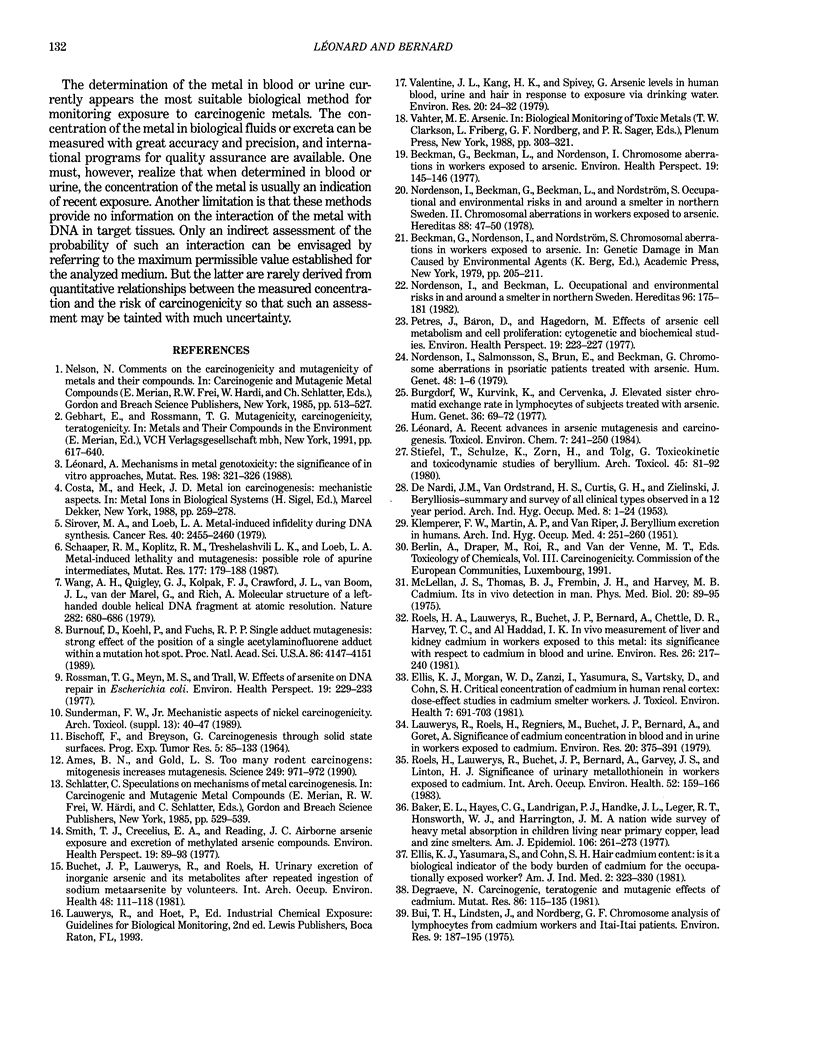
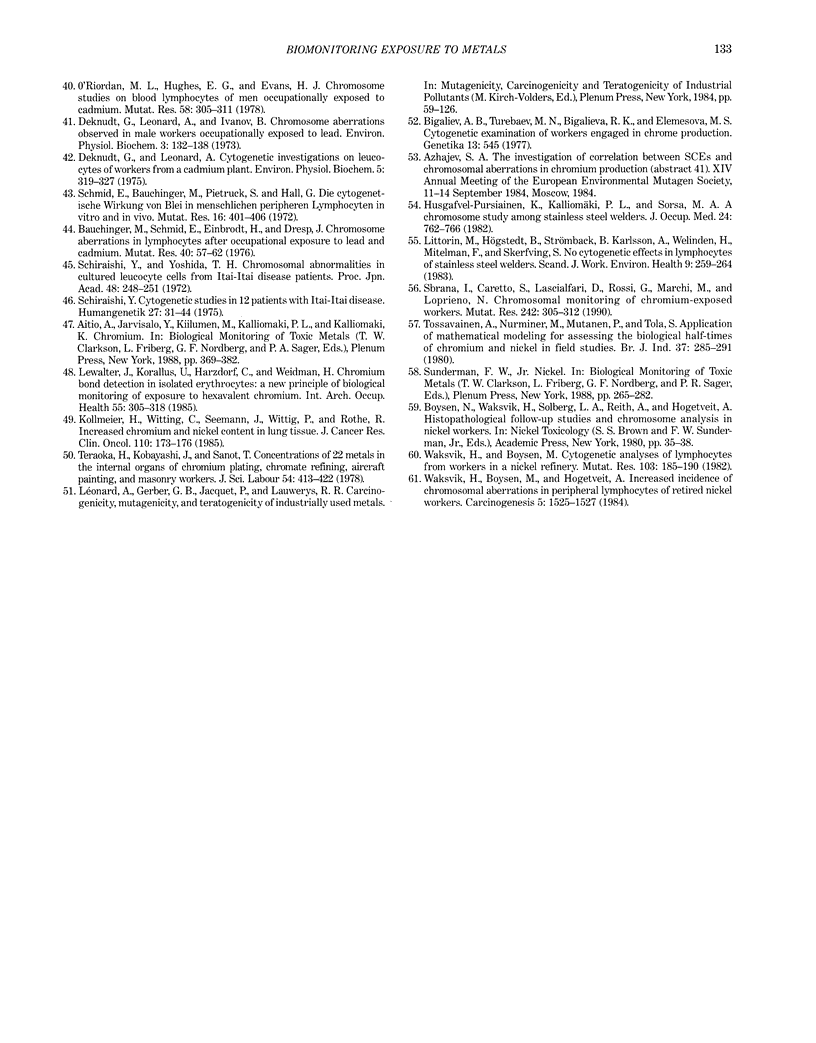
Selected References
These references are in PubMed. This may not be the complete list of references from this article.
- Ames B. N., Gold L. S. Too many rodent carcinogens: mitogenesis increases mutagenesis. Science. 1990 Aug 31;249(4972):970–971. doi: 10.1126/science.2136249. [DOI] [PubMed] [Google Scholar]
- Baker E. L., Jr, Hayes C. G., Landrigan P. J., Handke J. L., Leger R. T., Housworth W. J., Harrington J. M. A nationwide survey of heavy metal absorption in children living near primary copper, lead, and zinc smelters. Am J Epidemiol. 1977 Oct;106(4):261–273. doi: 10.1093/oxfordjournals.aje.a112462. [DOI] [PubMed] [Google Scholar]
- Bauchinger M., Schmid E., Einbrodt H. J., Dresp J. Chromosome aberrations in lymphocytes after occupational exposure to lead and cadmium. Mutat Res. 1976 Jan;40(1):57–62. doi: 10.1016/0165-1218(76)90023-9. [DOI] [PubMed] [Google Scholar]
- Beckman G., Beckman L., Nordenson I. Chromosome aberrations in workers exposed to arsenic. Environ Health Perspect. 1977 Aug;19:145–146. doi: 10.1289/ehp.7719145. [DOI] [PMC free article] [PubMed] [Google Scholar]
- Bigaliev A. B., Turebaev M. N., Bigalieva R. K., Elemensova M. Sh. Tsitogeneticheskoe obsledovanie lits, zaniatykh v sfere krhomovogo proizvodstva. Genetika. 1977;13(3):545–547. [PubMed] [Google Scholar]
- Buchet J. P., Lauwerys R., Roels H. Urinary excretion of inorganic arsenic and its metabolites after repeated ingestion of sodium metaarsenite by volunteers. Int Arch Occup Environ Health. 1981;48(2):111–118. doi: 10.1007/BF00378431. [DOI] [PubMed] [Google Scholar]
- Bui T. H., Lindsten J., Nordberg G. F. Chromosome analysis of lymphocytes from cadmium workers and Itai-itai patients. Environ Res. 1975 Apr;9(2):187–195. doi: 10.1016/0013-9351(75)90063-8. [DOI] [PubMed] [Google Scholar]
- Burgdorf W., Kurvink K., Cervenka J. Elevated sister chromatid exchange rate in lymphocytes of subjects treated with arsenic. Hum Genet. 1977 Apr 7;36(1):69–72. doi: 10.1007/BF00390438. [DOI] [PubMed] [Google Scholar]
- Burnouf D., Koehl P., Fuchs R. P. Single adduct mutagenesis: strong effect of the position of a single acetylaminofluorene adduct within a mutation hot spot. Proc Natl Acad Sci U S A. 1989 Jun;86(11):4147–4151. doi: 10.1073/pnas.86.11.4147. [DOI] [PMC free article] [PubMed] [Google Scholar]
- Degraeve N. Carcinogenic, teratogenic and mutagenic effects of cadmium. Mutat Res. 1981 Jan;86(1):115–135. doi: 10.1016/0165-1110(81)90035-x. [DOI] [PubMed] [Google Scholar]
- Deknudt G., Léonard A. Cytogenetic investigations on leucocytes of workers from a cadmium plant. Environ Physiol Biochem. 1975;5(5):319–327. [PubMed] [Google Scholar]
- Ellis K. J., Morgan W. D., Zanzi I., Yasumura S., Vartsky D., Cohn S. H. Critical concentrations of cadmium in human renal cortex: dose-effect studies in cadmium smelter workers. J Toxicol Environ Health. 1981 May;7(5):691–703. doi: 10.1080/15287398109530012. [DOI] [PubMed] [Google Scholar]
- Ellis K. J., Yasumura S., Cohn S. H. Hair cadmium content: is it a biological indicator of the body burden of cadmium for the occupationally exposed worker? Am J Ind Med. 1981;2(4):323–330. doi: 10.1002/ajim.4700020404. [DOI] [PubMed] [Google Scholar]
- Husgafvel-Pursiainen K., Kalliomäki P. L., Sorsa M. A chromosome study among stainless steel welders. J Occup Med. 1982 Oct;24(10):762–766. [PubMed] [Google Scholar]
- KLEMPERER F. W., MARTIN A. P., VAN RIPER J. Beryllium excretion in humans. AMA Arch Ind Hyg Occup Med. 1951 Sep;4(3):251–256. [PubMed] [Google Scholar]
- Kollmeier H., Witting C., Seemann J., Wittig P., Rothe R. Increased chromium and nickel content in lung tissue. J Cancer Res Clin Oncol. 1985;110(2):173–176. doi: 10.1007/BF00402735. [DOI] [PubMed] [Google Scholar]
- Lauwerys R., Roels H., Regniers M., Buchet J. P., Bernard A., Goret A. Significance of cadmium concentration in blood and in urine in workers exposed to cadmium. Environ Res. 1979 Dec;20(2):375–391. doi: 10.1016/0013-9351(79)90014-8. [DOI] [PubMed] [Google Scholar]
- Lewalter J., Korallus U., Harzdorf C., Weidemann H. Chromium bond detection in isolated erythrocytes: a new principle of biological monitoring of exposure to hexavalent chromium. Int Arch Occup Environ Health. 1985;55(4):305–318. doi: 10.1007/BF00377689. [DOI] [PubMed] [Google Scholar]
- Littorin M., Högstedt B., Strömbäck B., Karlsson A., Welinder H., Mitelman F., Skerfving S. No cytogenetic effects in lymphocytes of stainless steel welders. Scand J Work Environ Health. 1983 Jun;9(3):259–264. doi: 10.5271/sjweh.2411. [DOI] [PubMed] [Google Scholar]
- Léonard A. Mechanisms in metal genotoxicity: the significance of in vitro approaches. Mutat Res. 1988 Apr;198(2):321–326. doi: 10.1016/0027-5107(88)90009-7. [DOI] [PubMed] [Google Scholar]
- Nordenson I., Beckman G., Beckman L., Nordström S. Occupational and environmental risks in and around a smelter in northern Sweden. II. Chromosomal aberrations in workers exposed to arsenic. Hereditas. 1978;88(1):47–50. doi: 10.1111/j.1601-5223.1978.tb01601.x. [DOI] [PubMed] [Google Scholar]
- Nordenson I., Beckman L. Occupational and environmental risks in and around a smelter in northern Sweden. VII. Reanalysis and follow-up of chromosomal aberrations in workers exposed to arsenic. Hereditas. 1982;96(2):175–181. doi: 10.1111/j.1601-5223.1982.tb00847.x. [DOI] [PubMed] [Google Scholar]
- O'Riordan M. L., Hughes E. G., Evans H. J. Chromosome studies on blood lymphocytes of men occupationally exposed to cadmium. Mutat Res. 1978 Nov;58(2-3):305–311. doi: 10.1016/0165-1218(78)90023-x. [DOI] [PubMed] [Google Scholar]
- Petres J., Baron D., Hagedorn M. Effects of arsenic cell metabolism and cell proliferation: cytogenetic and biochemical studies. Environ Health Perspect. 1977 Aug;19:223–227. doi: 10.1289/ehp.7719223. [DOI] [PMC free article] [PubMed] [Google Scholar]
- Roels H. A., Lauwerys R. R., Buchet J. P., Bernard A., Chettle D. R., Harvey T. C., Al-Haddad I. K. In vivo measurement of liver and kidney cadmium in workers exposed to this metal: its significance with respect to cadmium in blood and urine. Environ Res. 1981 Oct;26(1):217–240. doi: 10.1016/0013-9351(81)90199-7. [DOI] [PubMed] [Google Scholar]
- Roels H., Lauwerys R., Buchet J. P., Bernard A., Garvey J. S., Linton H. J. Significance of urinary metallothionein in workers exposed to cadmium. Int Arch Occup Environ Health. 1983;52(2):159–166. doi: 10.1007/BF00405419. [DOI] [PubMed] [Google Scholar]
- Rossman T. G., Meyn M. S., Troll W. Effects of arsenite on DNA repair in Escherichia coli. Environ Health Perspect. 1977 Aug;19:229–233. doi: 10.1289/ehp.7719229. [DOI] [PMC free article] [PubMed] [Google Scholar]
- Sbrana I., Caretto S., Lascialfari D., Rossi G., Marchi M., Loprieno N. Chromosomal monitoring of chromium-exposed workers. Mutat Res. 1990 Dec;242(4):305–312. doi: 10.1016/0165-1218(90)90048-7. [DOI] [PubMed] [Google Scholar]
- Schaaper R. M., Koplitz R. M., Tkeshelashvili L. K., Loeb L. A. Metal-induced lethality and mutagenesis: possible role of apurinic intermediates. Mutat Res. 1987 Apr;177(2):179–188. doi: 10.1016/0027-5107(87)90001-7. [DOI] [PubMed] [Google Scholar]
- Schmid E., Bauchinger M., Pietruck S., Hall G. Die Cytogenetische Wirkung von Blei in Menschlichen peripheren Lymphocyten in vitro und in vivo. Mutat Res. 1972 Dec;16(4):401–406. doi: 10.1016/0027-5107(72)90208-4. [DOI] [PubMed] [Google Scholar]
- Shiraishi Y. Cytogenetic studies in 12 patients with itai-itai disease. Humangenetik. 1975;27(1):31–44. doi: 10.1007/BF00283501. [DOI] [PubMed] [Google Scholar]
- Smith T. J., Crecelius E. A., Reading J. C. Airborne arsenic exposure and excretion of methylated arsenic compounds. Environ Health Perspect. 1977 Aug;19:89–93. doi: 10.1289/ehp.771989. [DOI] [PMC free article] [PubMed] [Google Scholar]
- Stiefel T., Schulze K., Zorn H., Tölg G. Toxicokinetic and toxicodynamic studies of beryllium. Arch Toxicol. 1980 Jul;45(2):81–92. doi: 10.1007/BF01270905. [DOI] [PubMed] [Google Scholar]
- Sunderman F. W., Jr Mechanistic aspects of nickel carcinogenicity. Arch Toxicol Suppl. 1989;13:40–47. doi: 10.1007/978-3-642-74117-3_4. [DOI] [PubMed] [Google Scholar]
- Tossavainen A., Nurminen M., Mutanen P., Tola S. Application of mathematical modelling for assessing the biological half-times of chromium and nickel in field studies. Br J Ind Med. 1980 Aug;37(3):285–291. doi: 10.1136/oem.37.3.285. [DOI] [PMC free article] [PubMed] [Google Scholar]
- Valentine J. L., Kang H. K., Spivey G. Arsenic levels in human blood, urine, and hair in response to exposure via drinking water. Environ Res. 1979 Oct;20(1):24–32. doi: 10.1016/0013-9351(79)90082-3. [DOI] [PubMed] [Google Scholar]
- Waksvik H., Boysen M. Cytogenetic analyses of lymphocytes from workers in a nickel refinery. Mutat Res. 1982 Feb;103(2):185–190. doi: 10.1016/0165-7992(82)90027-6. [DOI] [PubMed] [Google Scholar]
- Waksvik H., Boysen M., Høgetveit A. C. Increased incidence of chromosomal aberrations in peripheral lymphocytes of retired nickel workers. Carcinogenesis. 1984 Nov;5(11):1525–1527. doi: 10.1093/carcin/5.11.1525. [DOI] [PubMed] [Google Scholar]
- Wang A. H., Quigley G. J., Kolpak F. J., Crawford J. L., van Boom J. H., van der Marel G., Rich A. Molecular structure of a left-handed double helical DNA fragment at atomic resolution. Nature. 1979 Dec 13;282(5740):680–686. doi: 10.1038/282680a0. [DOI] [PubMed] [Google Scholar]


